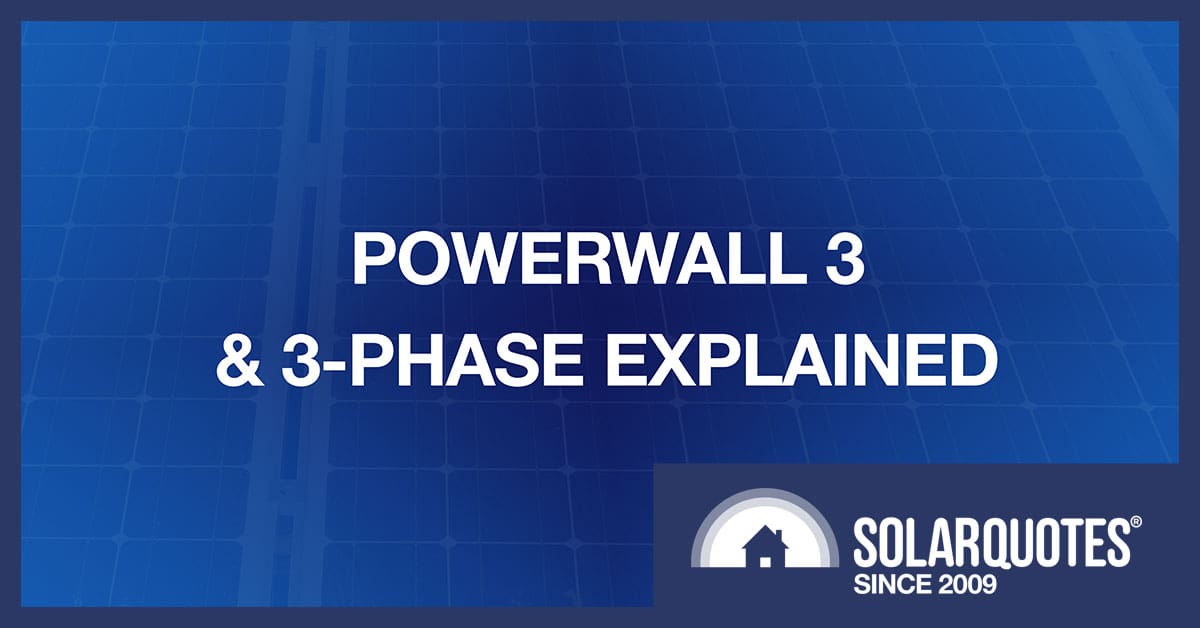
Australians sure are excited about the Tesla Powerwall 3, and we are getting truckloads of queries about it.
The most common question by far is:
Can I put a Powerwall 3 on my 3-phase home?
The short answer is:
Yes. Although the Powerwall 3 is a single-phase battery, it will work perfectly on a three-phase home while the grid is connected, offsetting your electricity bill on all three phases, just as it would on a single-phase home.
But when the grid goes down, the battery function will be compromised.
How the Powerwall 3 functions with your 3 phases will depend on how it’s wired into your home. In this post, I’ll go through all the ways this can be done that I can think of, so you can assess which configuration works best for you, or if you’d be better off getting a battery system designed for 3-phase homes from the likes of Fronius, Sungrow, iStore, SigEnergy or others.
In Australia, Powerwall 3s are installed with a ‘Backup Gateway 2’. The Backup Gateway 2 handles backup switching duties and the measurement of power flows in and out of your house, which the Powerwall control software uses for monitoring and control.
In all these scenarios, I am assuming you have a 3-phase utility meter, not 3 single-phase meters.
I also assume your local DNSP allows these configurations.
Your PW3 can be configured by Tesla to have 5kW, 10kW or 11kW output, depending on your local regulations. I’m assuming a 10kW version here.
Config #1: Powerwall 3 + Solar on a 3P home (no existing solar)
If you want to add a single Powerwall 3 and up to 20 kW of solar panels to a 3-phase home, the best way to do this is to add the powerwall and solar to one of the three phases like this.
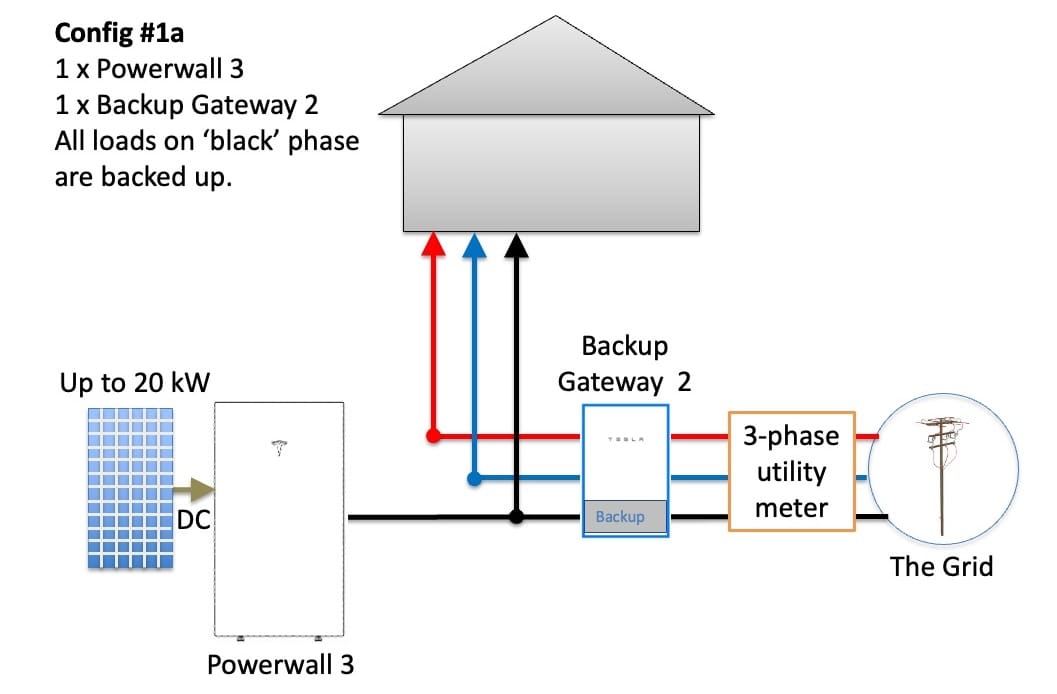
1 Powerwall 3, 1 Gateway 2, all the ‘black’ phase is backed up.
The Powerwall 3 accepts up to 20 kW of solar panels. Depending on the software configuration, it can charge the battery using solar, the grid, or both.
All 3 phases are offset for billing
Although the Powerwall can only discharge on the black1 phase, the Gateway measures the power flows on all 3 phases, and discharges enough on the black phase to cover the power coming in from the grid across all phases. The 3-phase utility meter subtracts the power flow going out of the black phase from any power coming in on the blue and red phases, and only bills you for the difference. If the battery has enough energy, that will be zero dollars2. There is a detailed explanation of this with pictures here.
Only the black phase is backed-up
If the grid goes down, the house will lose the blue and red phases. Only the black phase will be backed up, and the solar going into the PW3 will still operate just fine. So, all the essential circuits should be placed on the black phase.
You can have non-backed-up circuits on the black phase
If there are loads on your black phase that you don’t want to back up (for example one phase of a 3-phase appliance) you can have a non-backed up circuit on the Powerwall phase.
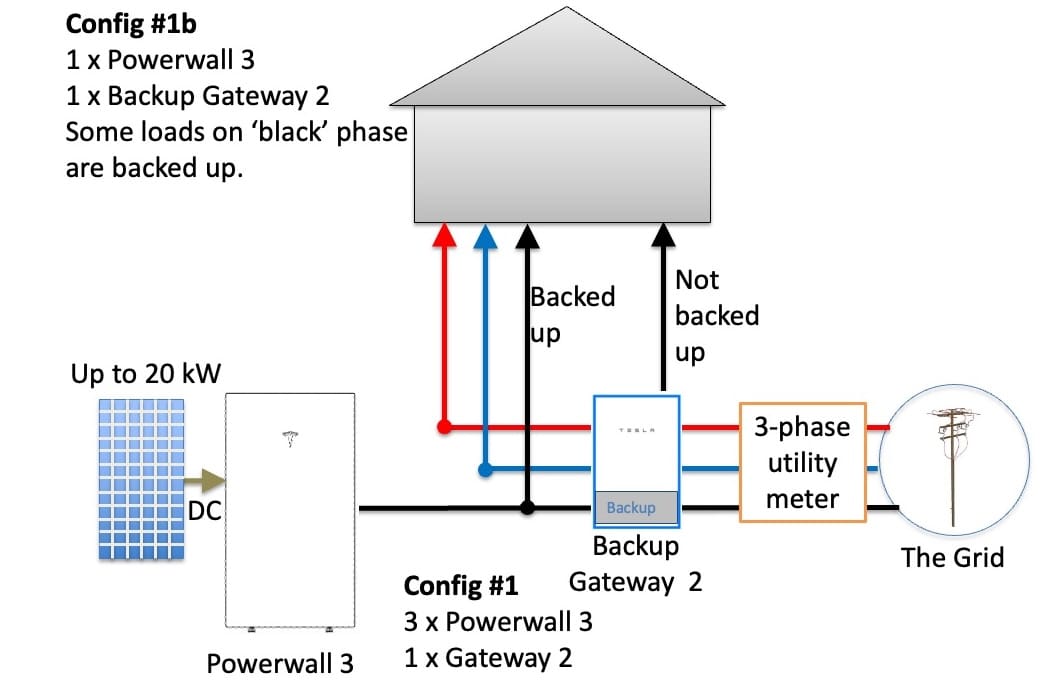
1 Powerwall 3, 1 Gateway, Some loads on black phase are backed up.
Config #2: Powerwall 3 on a 3P home with existing single-phase solar
If you have existing solar and your inverter is 5kW or less, and you want to retrofit just a battery, you can use a Powerwall 3 as shown.
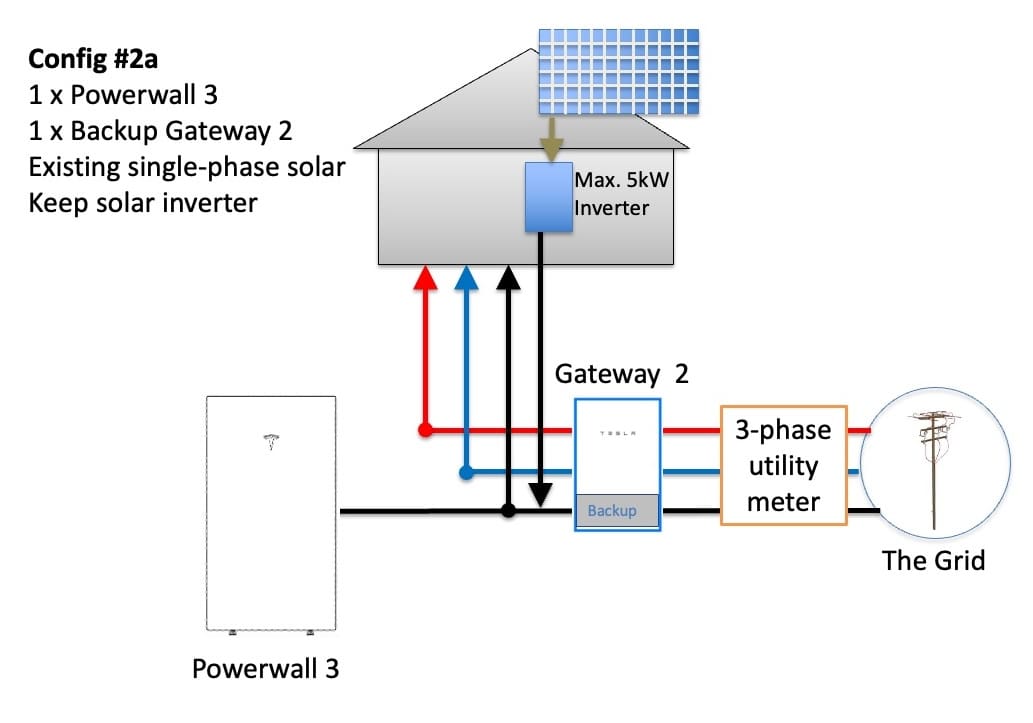
1 Powerwall 3, 1 Gateway, existing single-phase solar keeping solar inverter
The existing solar goes on the same phase as the PW3, and the existing solar inverter can charge the battery with AC power.
If the grid goes down, the black phase is backed up, and your solar inverter will stay online.
Ditching your solar inverter
An alternative variant is to disconnect your existing solar array from your old inverter and plug it into the PW3:
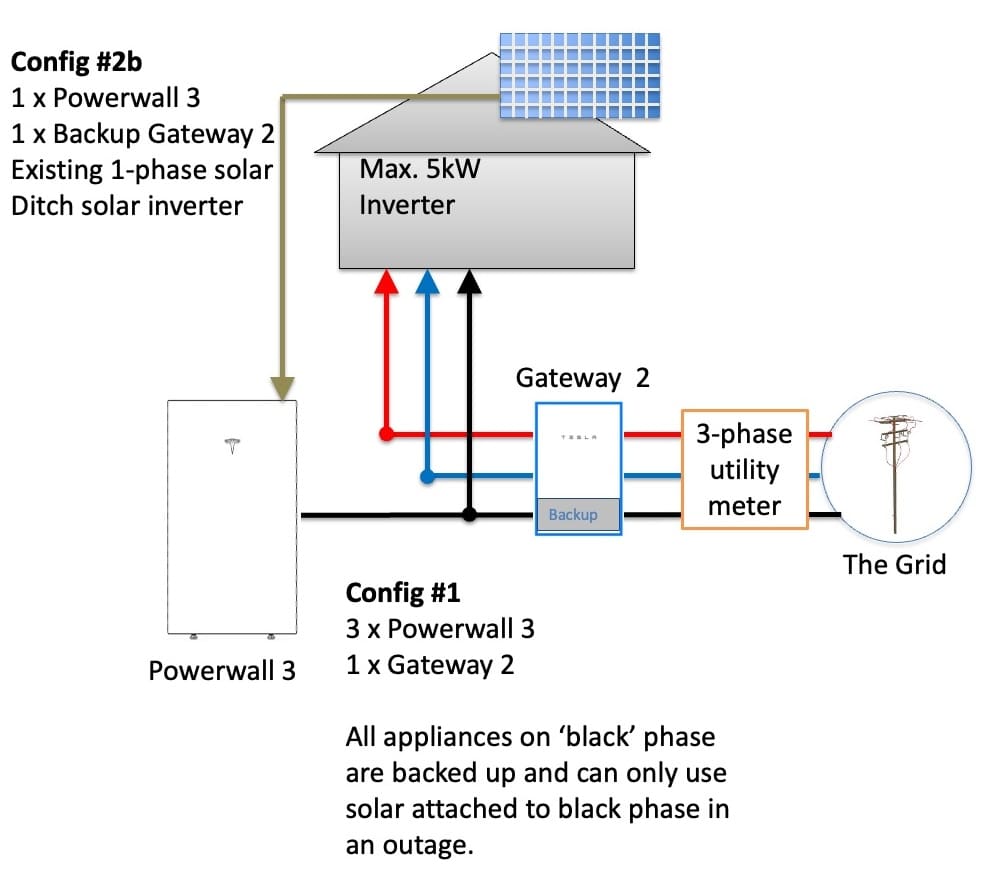
1 Powerwall 3, 1 Gateway, existing single-phase solar ditching solar inverter
This has many advantages:
- One less inverter on the wall.
- You get a 10-year warranty on the PW3’s internal solar inverter.
- Battery charging is a little more efficient
- Better monitoring of the solar all through the Tesla App
- Better control of the solar
Whether this is possible will depend on the age of your solar panels and your local network rules. Your installer can advise.
Local rules may force you to ditch your old inverter. See the end of this post for more details.
Powerwall 2 is a cheaper option
If you have existing single-phase solar and want to add a battery on 3 phase, the Powerwall 2 offers the same storage and 5 kW of output for at least $1,500 less.
Config #3: Powerwall 3 + solar on a 3P home with existing single-phase solar
The smart way to configure this is to put the existing solar on one of the 2 non-Powerwall phases and the new solar into the Powerwall.
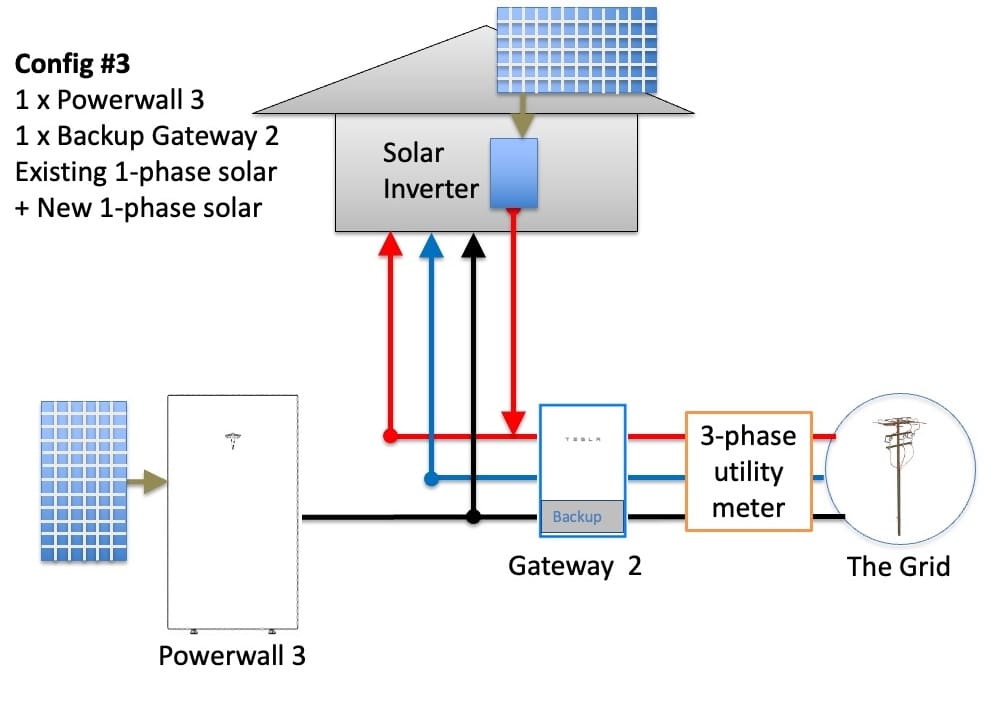
Existing 1-phase solar
+ new 1-phase solar
You won’t have to touch the old solar (or its warranty), and that old array will do everything except charge the battery in an outage.
Config #4: Powerwall 3 on a 3P home with existing 3-phase solar
If you’ve got a roof full of solar on an existing 3-phase inverter, you have some options.
Option 1. Use Powerwall 3 just as a battery
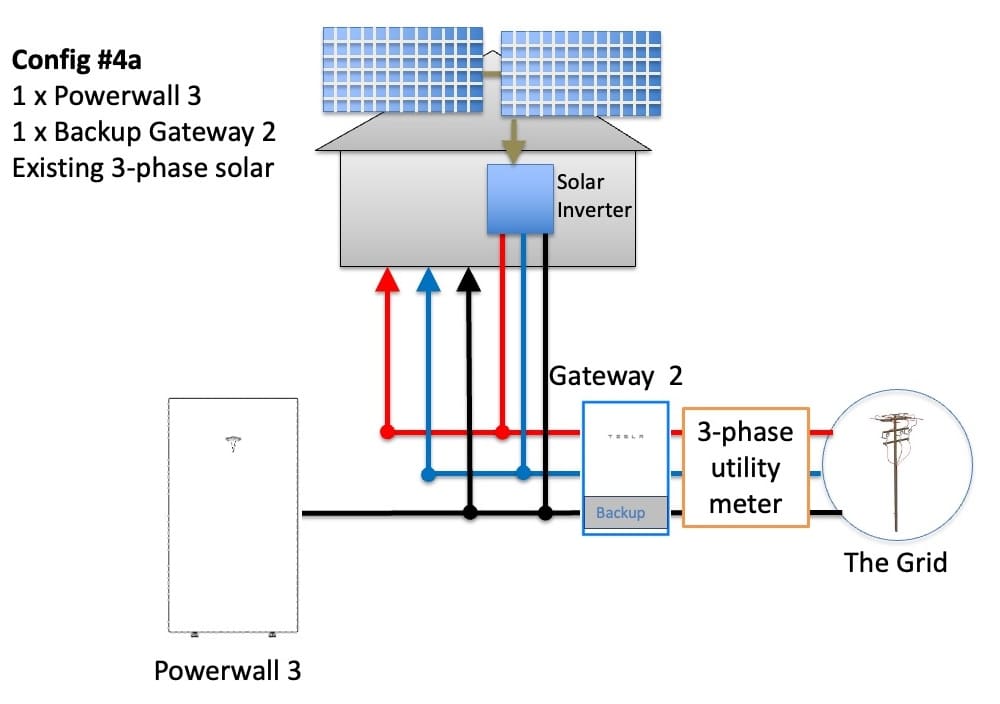
Existing 3-phase solar
In this configuration, the black phase will be backed up, but you’ll have no solar during an outage, because your solar inverter needs a 3 phase supply to operate.
Option 2. Put some or all of your solar into the single-phase Powerwall 3.
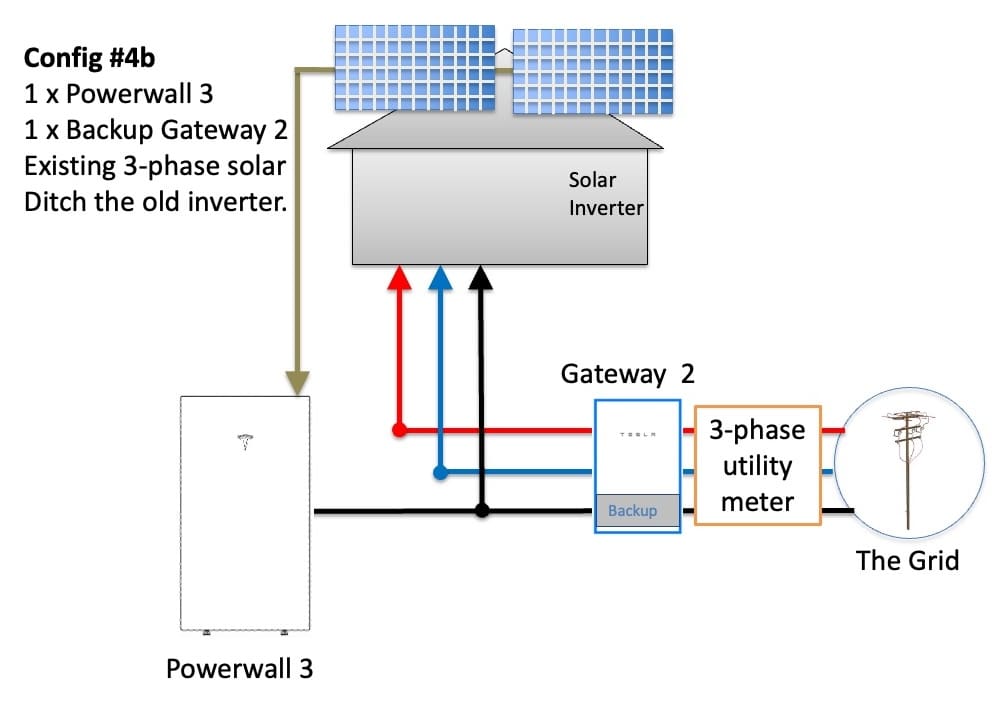
Existing 3-phase solar into the PW3
If your solar array is 20kW or less, it is plugged into the PW3 and will operate during an outage. When connected to the grid, all your solar will work.
Whether this is possible depends on age of your panels and your array design. A good installer can advise. Tesla warranty is not affected by connecting legacy panels.
One issue with putting all of the old solar through the PW3 is that you may encounter voltage rise issues when exporting lots of solar out of one phase instead of across 3, your solar will be clipped at 10 kW when the battery is full, and your DNSP might prohibit it (Hello WA!).
Config #5: Powerwall 3 on a 3P home with existing microinverters.
Only the microinverters on the same phase as the PW3 will work in an outage. You can only have 5kW of micros on the black phase. With the grid connected all the micros across all 3 phases will work fine.
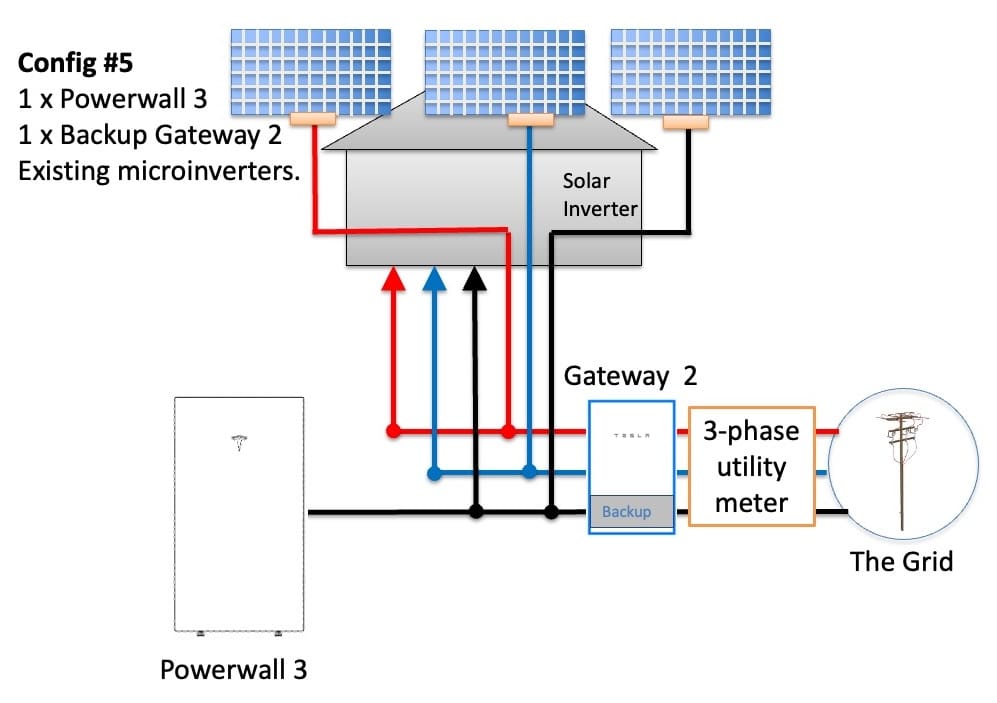
MIcroinverters
Config #6: Three Powerwalls on one phase of a 3-phase home.
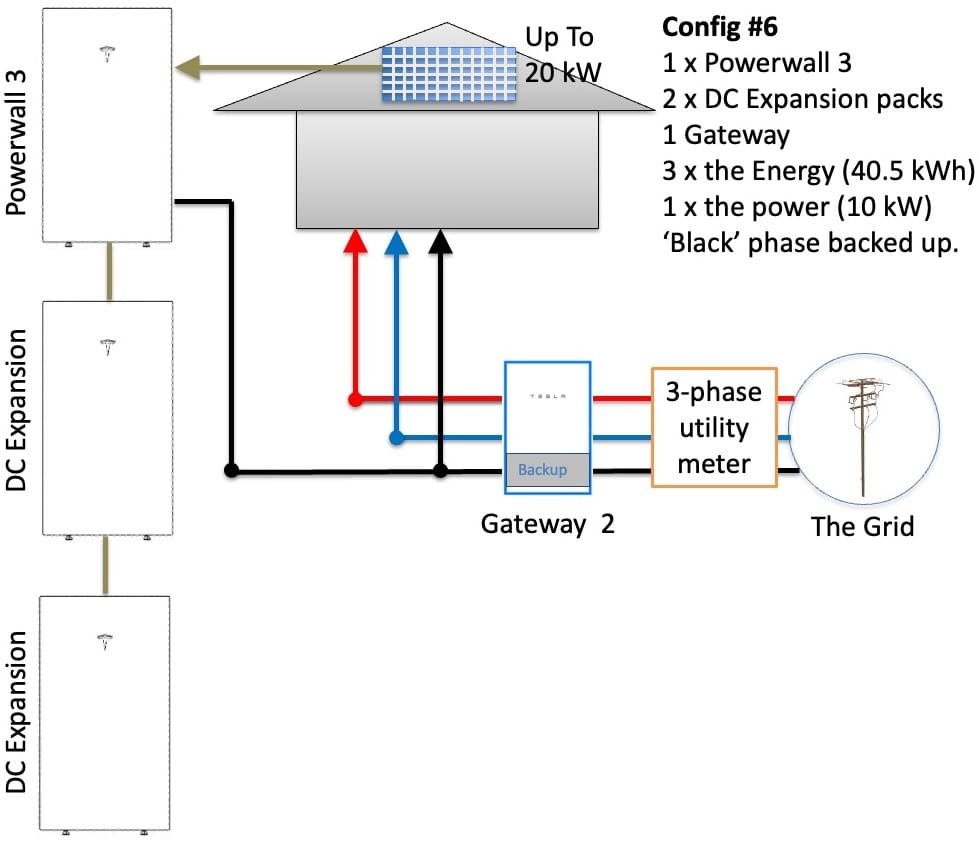
Three batteries an a single phase
Putting 3 Powerwall 3s on a single phase is not allowed by many DNSPs because it adds up to 30 kW of inverters on a single phase. The solution – if you want this setup – is to wait for the DC expansion packs which are battery-only and no inverter.
We’re told expansion packs are set to be keenly priced, and they’ll allow you to soak up solar faster.
Config #7: Three Powerwalls. One on each phase of a 3-phase home. One Gateway.
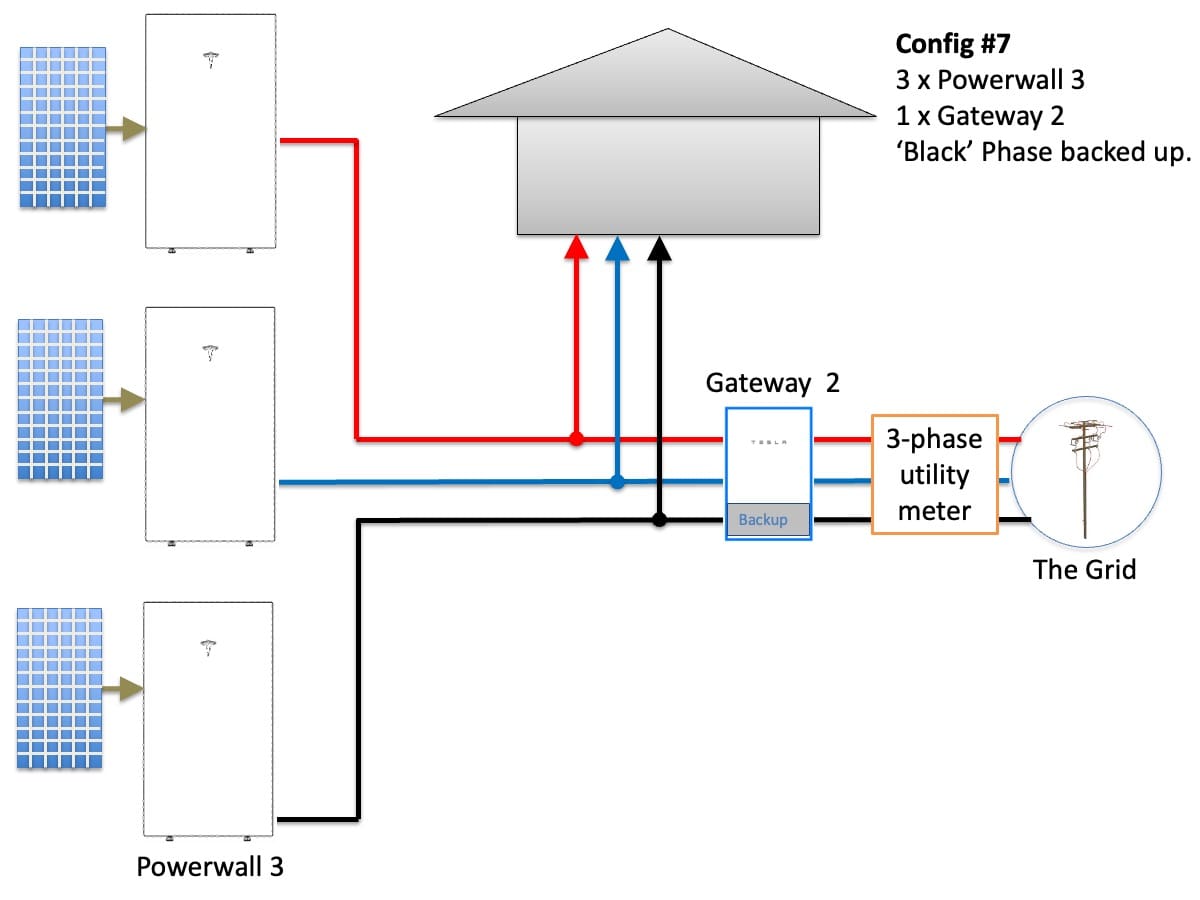
One battery per phase, one gateway
When the grid is connected, this will work exactly as you expect, with 3 x the energy (40.5 kWh) and 3 x the power (30 kW). In an outage you will only be able to use one Powerwall, which will back up the solar and loads on that phase only.
Config #8: Three Powerwall 3s on a 3-phase home with 3 Gateways.
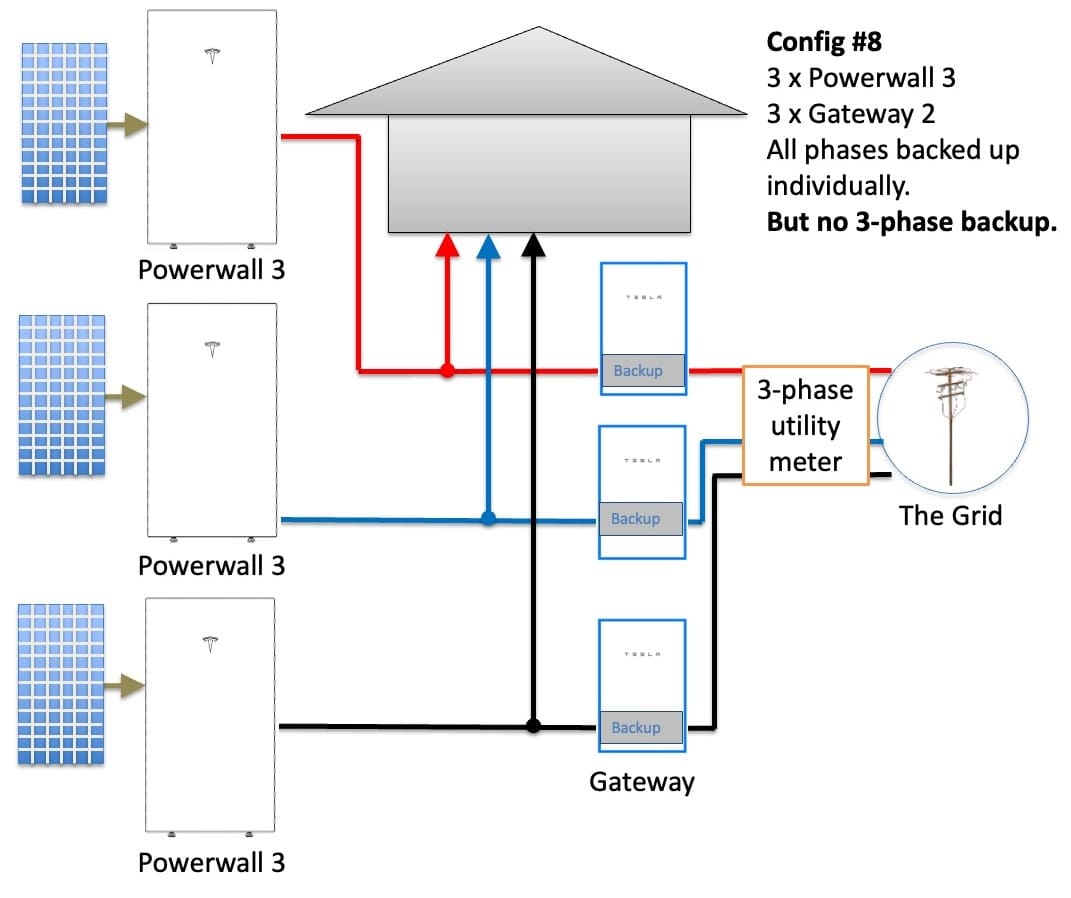
Three PW3s, 3 gateways, no 3-phase backup, lots of money and wall space.
Each phase is backed up individually, but it is not a 3-phase backup, as the phases are not synced. If a 3-phase appliance is attached, it won’t work in a warranty and should be on the non-backed-up circuit of each phase3.
This is a very expensive way to not back up a 3-phase home. Don’t do it—just buy a proper 3-phase battery system from Fronius, Sungrow, SigEnergy, etc.
Some notes about Western Australia and Powerwall 3 Throttling
If you’re lucky enough4 to live in the West, where 5kW per phase is the maximum allowed, PW3 is available as a 5kW nominal machine. Once it’s been commissioned though, there’s no unlocking it to unleash the full 11kW of power, unless you contact Tesla with bulletproof documentation from the DNSP that it’s allowed.
Seeing as the PW3 doesn’t charge at more than 5kW, the derating isn’t as bad as it might sound but sadly the backup capacity during an outage is also throttled to 5kW. I’ve spoken to Tesla and they’re trying to convince the regulators that’s a silly idea.
These 5kW Sandgroper Spec™ units will prove popular elsewhere as a workaround solution for those who simply must have a Tesla, but whose local network (DNSP) mandates a maximum 5kW balance between phases.
For example, if you have an existing 10kW 3 phase inverter, there’s effectively 3.3kW on each phase. An additional 10kW isn’t likely to be approved but 5kW will sail through automatically.
Perhaps you have a Fronius Primo 5kW inverter on phase A, a full sized 10kW PW3 could go on phase B, however you’ll need an additional 5kW of single phase generation on phase C to balance things up. I always recommend more solar so don’t be discouraged.
However if you don’t have more roof space, it makes sense to get a 5kW PW3 to balance your legacy Fronius, leaving the other phase alone.
Local Rules May Force You To Ditch Your Old Inverter
Flexible exports or dynamic connections are standard across SA, optional in Qld, coming soon to NSW, and becoming law in Victoria in less than a month. Once more, your DNSP rules need to be consulted carefully, but in many places, this means the faithful old SMA SunnyBoy TL5000 you bought 12 years ago will be forcefully retired.
The need to have network control for solar means old inverters that can’t be bridled with an internet connection can’t be used when you apply for a new PW3 to be connected. Sadly that means a deal of e-waste will be created but one silver lining is that Tesla’s very good monitoring app will let you know when the DNSP throttle has been applied, a feature only CatchPower has offered up until now.

 RSS - Posts
RSS - Posts



If you had a Tesla wall charger wired up for 3 phase, would it fall back to single phase charging via solar in an outage?
OK – a bit surprised that 3 x Powerwall 3’s can’t form a 3 phase grid connection. Would have thought that was a fairly basic thing for Tesla to implement.
Powerwall 3s cannot form 3 phase without the grid
Ahhh, so easy when you don’t have any idea. To forma three phase grid the three inverters have to synchronise a 60Hz waveform to about 1% accuracy. That’s not easy for three individual devices at all. If you design a three phase inverter from the start, no problem as one controller is forming all three. Three phase isn’t just three separate wires. It’s three wires with the phases (an important word) 120 degrees out of sync with each other, and all galvanically referenced to a common earth *and to each other*. If you want a three phase battery, buy a three phase battery. And if you want a single phase battery, buy something other than a PowerWall.
Irony in investing in large solar setup 20kw/3phase and then years later realising if you wanted to blackout proof the house you were better off with a 6kw single phase setup..
The costs of this is astronomical and still makes no sense, I think our previous quote to have 3 phase backup in the house was 35k’ish with the range going from 30-45k between quotes.
Unless your rural and need it, makes no sense at all.
rather 20 kw long term and sigenergy will back up 3 phase
It sounds like you were quoted before the newer three phase hybrids from Sungrow became available a few months ago. The three phase Sungrow hybrids can provide full house backup and Sungrow even supports them for 100% off-grid applications with a generator as well. Will be much cheaper than what you were quoted in the past.
And if you live in NZ, you’re SOL with 3 phase, because the power companies don’t do net metering per phase.
What that means is that if your PW3 is on Phase A, and you’re using 5kW on Phase B, the PW3 will output 5kW on Phase A to “offset” your Phase B usage producing a net usage of zero! Right? Right??
Sorry mate, not in good ol NZ that treats 3 Phase as 3x single phases for billing.
In the above example, you’ll be paying retail prices for the 5kW you use on Phase B (e.g. $0.25/kWh), and get the wholesale buy rates for the 5kW you supply on Phase A (e.g. $0.12/kWh).
Thanks for the clarification regarding the Kiwi situation. We have 3 phase solar, with no battery so will look for a HV DC battery if we add one.
I’m looking to install solar on our new 3-phase home in South Australia. This will be our forever home that we’ll like to future proof for our EV’s, etc. The maximum amount of solar we would be able to fit on our roof would 23.0kw exactly.
Our local installer has suggested we go with Config #7: Three Powerwalls. One on each phase of a 3-phase home. One Gateway.
Would 23kw be fine for this setup, even though there’ll be below 10kw of solar generation on each phase?
Hi Ben,
That’s a lot of money invested in a lot of Tesla storage for a system that won’t run a 3 phase load. Assuming you have nothing but single phase appliances there’s no reason it won’t work, but it’s not what I’d call a native solution. There may be opportunities to charge from the grid for cheap and derive benefits from the storage without having 60kW of solar.
A year ago I would have said Fronius Gen24 10kW, 15kW of solar with BYD battery and Wattpilot EV charger.
For something off the shelf right now Sungrow 20kW hybrid, but they don’t have a cheap EV charger.
GoodWe offer a large 3ph hybrid and a decent EV charger too.
I’d also be inclined to look at Sigenergy just at the moment and hope they’re approved soon.
Hi Anthony
Some of Sigenergy’s batteries have been approved by the CEC. Which Sigenergy products are still waiting for approval?
Hi J,
I think the three phase units are all still to come but the single phase solar inverters (without battery) are most recently approved if I recall correctly.
Thanks for the info Anthony.
Having the extra storage is definitely a plus for us, and every appliance is single phase except for the ducted air conditioning and Tesla Wall Connector.
Regarding having x3 Powerwall 3’s on a 3-phase home (a Powerwall 3 on each phase), since the maximum amount of solar I can fit on my roof is 23.0kw, would it be worth having 10kw of solar connected on 1 phase (the phase selected for backup) and 6.5kw of solar connected on each of the remaining 2 phases?
Also, if you had a Tesla wall charger wired up for 3-phase, would it fall back to single phase charging via solar in an outage (hence having 10kw of solar connected on 1 of the 3 phases)?
Thanks
Out of interest, why is the fronius/byd setup recommended 12 months ago not recommended now?
I’m considering waiting another couple of years for Tesla to release proper 3ph support and also for the expansion pack availability.
I recommend reading Table 6 of Energex/Ergon’s Solar connection standard and updating your blog. On a three phase supply, when multiple Inverters are used where at least one inverter is single phase and the aggregate capacity on any one phase exceeds 5kW – Phase Balance Protection is required along with RPEQ signoff. As it currently stands, to achieve this you are looking at a Network Protection system that monitors current (is. An IntelliPro relay) that can disconnect the IES when phase imbalance occurs. Very costly.
We’ve got a 3-phase house & 3-Phase 11kW Tesla EV charger. (& EV)
There are three separate flats on the same MMI at our address.
We don’t necessarily need three-phase backup because the electricity supplies quite reliable here.
My main goal here is to best utilise Amber Electric for arbitrage (to help recover investment costs quickly) & to utilise daytime energy for overnight consumption especially in the cold winter to avoid using the grid for heating.
We’re currently plan to get to powerwall threes to cover our site needs overnight, and connect our existing 6.6 KW PV.
(Plan to give a friend our old solar inverter)
Ausgrid network NSW
I would greatly appreciate any expert or other advice about if this setup seems reasonable for our needs.
Thanks
I understand 3 x Telsa Powerall 3 (1 per phase) wont form a true 3 phase supply under back up (like Sigen/FroniusGen24/Sungrow) however I thought it would at least supply 3 x single phase 240V supplies – albeit out of phase so no good for 3 phase loads. Reading this it appears that only 1 Powerwall 3 will run during an outage – is this correct? Thanks
It depends on how many Gateways you have. Look at Config 7 vs Config 8.
If I put 2 x PW3s on a 3 phase supply, would I be able to export 10 kW, or 20 kW?
Great article. So if I understand this correctly. I’m looking for a 15kw solar installation and was considering a PW3. Assuming perfect conversion and to keep the maths simple. Where the PW3 is empty I can consume 5kw charging the battery and *upto* 10kw of self consumption or export. When the battery is full, I can only utilise 10kw of power generated from my solar (internal and export combined)? Essentially a pretty poor use of some of my panels. If this is correct, then 20kw of solar panels is a terrible waste.
You are correct about how the PW3 works, but wrong about “20kw of solar panels is a terrible waste”. 20 kW of panels will almost never generate 20kW, but it will mean you spend much more time generating 10kW (mornings, afternoons, non-perfect solar days). Putting only 10kW of panels on a 10 kW inverter is a terrible waste because you’ll almost never get the 10kW, and panels are so cheap.
(In NSW) I’ve been advised that if you install a single Powerwall 3 on a 3-phase home, that the Powerwall 3 will be locked to 5kw (meaning max viable solar will be 10kw(200%)). It was explained to me as being a requirement that the phases be balanced (i.e. 1 pw3 on each of 3 phases will allow for each pw3 to be 10kw). Is this true/untrue/unknown? It doesn’t seem to be what is suggested in this article, but i gather there won’t have actually been many (if any) pw3 installations right at this moment?
The specific rules will depend on your local DNSP – there are 3 in NSW (Ausgrid, Endeavour and Essential) each with their own rules. If you have to throttle the PW3 to 5kW due to a silly phase balancing mandate, then you can still connect 20kW of solar to the PW3. We’ve had this confirmed by Tesla. And it won’t violate the latest install rules, because the AC-coupled battery negates the old oversizing rule. A 5kW throttled PW3 will be able use 10kW of solar: charge the battery at 5kW and output 5kW simultaneously, as the DC battery charger and the AC solar inverter are separate.
Thanks for replying. If we did need to throttle it due to this rule, would you consider a 20kw system and a pw3 to still be a quality option for a new home with 3 phase power?
For context, our DNSP will be Endevour energy, and we’re building a new home. We won’t have any true need for the home to be 3 phase, except for a desire to have faster EV charging, and potentially a 3 phase air con and heat pump. We’re at a cross roads (choosing between having the home wired single or 3 phase) and it seems like there are major downsides either way (having a pretty great 20kw / pw3 system throttled) or only have a single phase connection to the home.
Hi Callum,
There may be a third way forward for you but you’ll need an electrician on board and potentially a co-operative DNSP.
First apply for the largest single phase connection the DNSP allows. Assuming it’s not against the service and installation rules, they may let you run the 4 cables needed for 3 phase, but connect them in parallel, or simply leave two of them as spares. That way you have the wires needed for 3 phase later.
Next arrange a large switchboard capable of handling 3 phase and a full electrified house.
https://www.solarquotes.com.au/blog/get-a-bigger-switchboard/
And ensure the electrician knows you are potentially looking at upgrading. They may wire a 3 phase main switch and distribute the loads across it, then simply bridge them together for a single phase incoming main.
This would get you a full 10kW (or even 11kW ??) PW3 with the ability to change things later if you really need 3ph EV charging or bidirectional EV charging.
Just a reminder. I commented on your last PowerWall articles asking why Tesla is removing local control from their batteries, forcing you to use their API and send all commands via their servers, and why they are then planning to charge for the use of that API. And why the PowerWall 3 has zero local control at all. You answered that those were good questions and you’d ask Tesla. Haven’t heard anything. If you do actually ask them, when they respond that it’s a security concern, you can reply that actually centralising is the security concern, as a bad actor only has to compromise one system to play havoc with the grid, whereas having to hack every PowerWall out there is a nightmare. You can also add another question: why do they delay discharge via their app by 5 minutes from when you tell it to discharge? This is an evil company getting worse every day.
Hi Phil,
I’ll ask them again but haven’t had an answer yet.
Cheers
I’m installing a 3 phase supply and a 3 phase EV charger (22kw) with 13kw solar. Will the PW3 be able to export enough power on one phase to offset the consumption on the other phases of the EV charger? In NSW with Ausgrid. If not would a 3 phase inverter and battery be cheaper to run for charging the EV.
Apologies if this is an obvious question – i’ve read lots of the blogs and I still can’t understand.
Hi Craig,
Even if you could get an approval for 11kW of Tesla, you’d need two of them to export enough to meet the load of a 22kW EV charger.
Regardless the mismatch in load across phases may cause the solar to be curtailed as it drives voltage up and the EV pulls it down on other phases.
I would recommend as much solar as you can get. 13kW isn’t the limit, a PW3 will handle 20, I put 38kW on for my Mum, given a battery she could have 45kW.
When it’s terrible weather and only making 10% yield… 4.5kW would still be very useful where 1.3kW will be pretty modest.
If I am installing Powerwall 3 on config #1. Will PW3 be able to charge from solar when the grid is out?
yes
Will the PW3 be able to recharge / blackstart in an extended outage on 3 phase? So if it drains overnight, can it recharge in the morning when the suns up?
Hi Toby,
PW3 is a single phase machine. Provided there’s DC coupled solar connected to the PW3 then it’ll black start and whatever single phase loads are connected will be backed up.
You can’t have 3ph AC coupled solar charge the PW3 unless the grid is available.
Hey All,
I’ve got Config 4.
28x 330w Panels = 9.24kW
Fronius Symo 3 phase 8kW inverter
System has been paid off thanks to this website 4.5 years ago but unfortunately I was stung by the Solar Analytics subscription saga so now I want to consider a battery to get these stats up again.
Keen to understand abit more on option 1 and 2.
I understand that Option 1 has no backup during outage (Quite rare here)
and option 2 has backup for the 1 phase during outage.
If I go option 2 and ditch the 3 phase inverter – is there anything I am “missing out on” by going direct to the single phase gateway/battery?
All I see is a “gain” to have backup during an outage and also possibility of adding on more solar panels or replacing/upgrading existing panels to 440w or higher.
i.e. Should I really ditch the current inverter? I don’t even know what benefit there is of keeping it!
note: I have 2 Tesla’s in the household and charge via the Wall connector that is rated to 22kW.
Thanks in advance!
I’m looking at installing Option #1. In this article it says “All 3 phases are offset for billing” and the linked article (if I read if correctly) say power is exported on one phase to offset ‘imported’ power on the others. The sum total of imported power minus exported power is what my usages charges would be calculated on.
What happens if/when we start to get charged export tariffs? Would the tariffs apply to the power being exported( to offset the imported power) or would tariffs only apply to a sum total of exported power?
Thanks in advance
The export tariffs would only apply to a sum total of exported power (because that’s what the smart meter would report).
Hi
I had planned to install an single phase inverter on one of the phase of my 3 phase home. I was informed that this may not be possible due to the regulation from AS4777 Section 5.2 shown below. Does this rule apply to when only a single inver is connected (e.g. not a “multi phase inverter system”) like the PW3
Section from AS4777
5.2 Inverter current balance across multiple phases
In a multiple-phase inverter energy system comprised of individual single-phase inverters, the a.c. current output should be generated and injected into the multiple-phase electrical installation to minimize current imbalance. The maximum current imbalance in a multiple-phase inverter energy system comprised of either individual single-phase inverters connected on separate phases or a combination of single-phase inverters and multiple-phase inverters shall not exceed 21.7 A for more than 15 s.
NOTE 1 This maximum current imbalance also applies to multiple mode inverters used in an inverter energy system that may have a charging mode.
Hi Peter,
Balance across 3 phases is normally restricted by the DNSP to 5kW, ie 21.7amps
So you could have an 8kW hybrid with a further 3kW and 5kW solar inverters on the other phases for instance.
Or you may get permission to have a different combination depending on the network.
https://www.solarquotes.com.au/grid-connection/
There’s more reading here :
https://www.solarquotes.com.au/blog/3-phase-battery-backup/
https://support.solarquotes.com.au/hc/en-us/articles/6192150320783-1-2-or-3-Phase-What-does-it-actually-mean-when-you-talk-about-electricity-supply-
https://support.solarquotes.com.au/hc/en-us/articles/6030114486799-How-do-3-phase-meters-work-with-single-phase-solar-
https://support.solarquotes.com.au/hc/en-us/articles/115001596554-How-does-a-single-phase-inverter-on-a-3-phase-supply-affect-my-self-consumption-
I have a different scenario. Three phases into the house, one of them is a controlled load. We have a flat (expensive) rate from the retailer, ie no time of day charging and copper coins for the feed in tariff.
Two inverters for two solar systems, one outputting 7kw, the other 8kw.
Is there an option where I can charge the battery from the mains on the controlled load phase but output across all three phases. I’d guess that would also mean no backup power. Or only maintained on the controlled load circuit .
I am pressuring the retailer to give us time of day pricing – I really don’t understand why I can not have it!!
I have an existing SMA SL5000 inveter with Panels (from 2012). Trying to get Config 3 installed with PW3 and more panels in Western Australia.
Why do installers tell me this isn’t allowed and keep trying to talk me into removing the existing system and install the new?
Really want Config 3, so I can generate more than 5kw to cover my Air Conditioner in Summer as well as the benefits of the battery.
Hi Robert,
I think you should be able to do config #3 as you’re requesting, but PW3 in WA needs to be throttled to 5kW.
PW3 can probably have your old solar array connected to it, along with the new solar but the only reason you’d do that is so all the solar works during an outage.
While PW3 is very gutsy for surge capacity to back up a single essential phase, would consider a 3 phase unit. ie 12kW Fronius Gen24, or 15kW hybrid inverter from Sungrow, GoodWe or perhaps Sigen instead.
More solar is always more but the WA rules make it difficult; unless you go really and truly resilient with an Australian made Selectronic SpPro or three.
Hi there, I’m one of the “lucky” ones living in the Sandgroper state of Western Australia.
My question is specific to config 4B. I have an existing 3 phase solar system, and I don’t mind ditching the Solax X3 Pro G2 inverter. I also have a Tesla vehicle and the associated 3 phase wall charger.
Since WA has that 5kW limit, and I have 18 kW of solar panels, what happens to the remaining 13kW of solar generated on a very sunny day, and the battery is full? Am I able to use any of that 13kW in the house, since the inverter within the PW3 is called at 5kW?
Hi Chet,
As far as I’m aware the 5kW PW3 limit is just that, an outright power limit so the inverter will not generate more.
DC solar will charge a DC battery but beyond that it can’t be used in the house.
Your 5kW will be drawn by the house primarily & the grid takes up surplus yield.
If you get something like a Selectronic SpPro then it can function “off grid” to supply more energy to your house without needing DNSP approval.
Or perhaps Sigenergy will allow DC charging straight into an EV.
Things have moved on a lot since this article was first written.
There are plenty of more suitable and acceptable battery solutions whether you have single or three phase mains.
Another option to consider is the Battery Emulator project which hundreds of people around the world are using to re-purpose EV batteries for second life usage.
https://www.patreon.com/posts/time-to-update-125431381